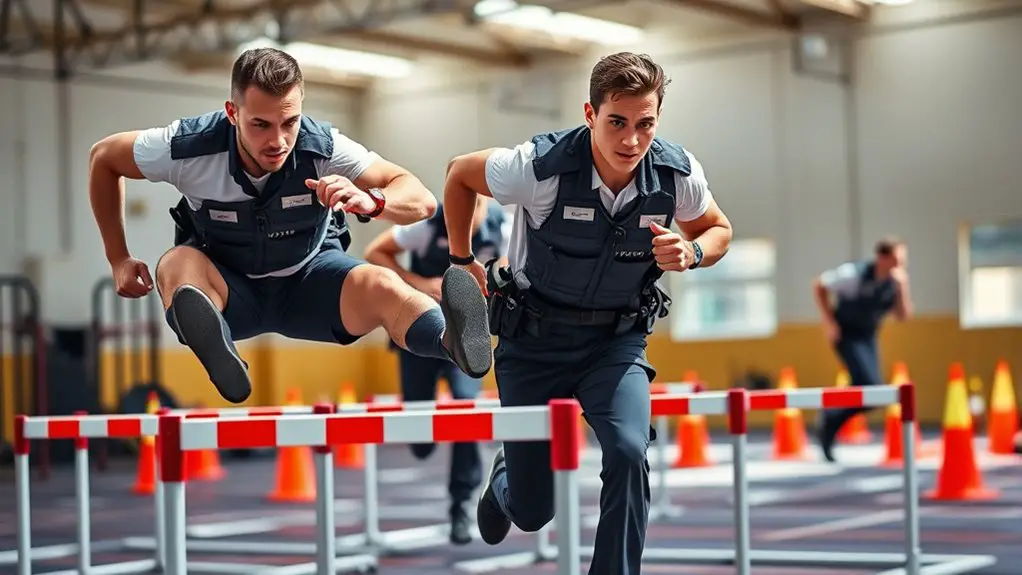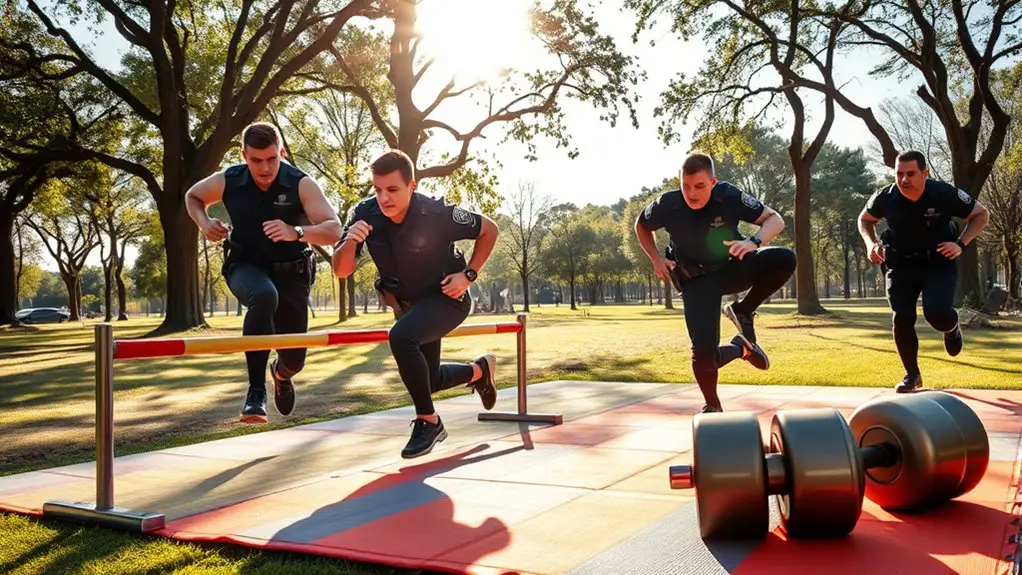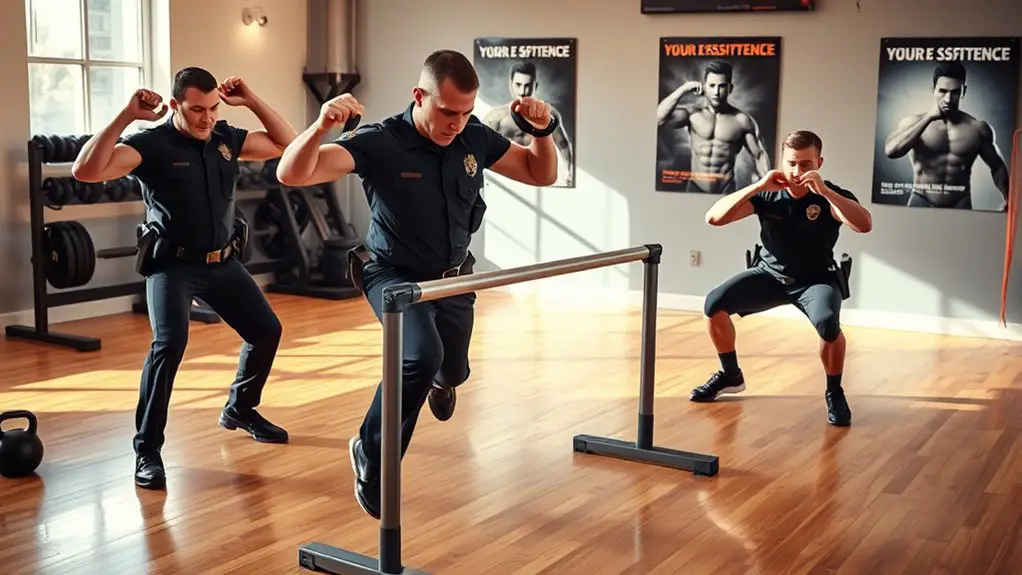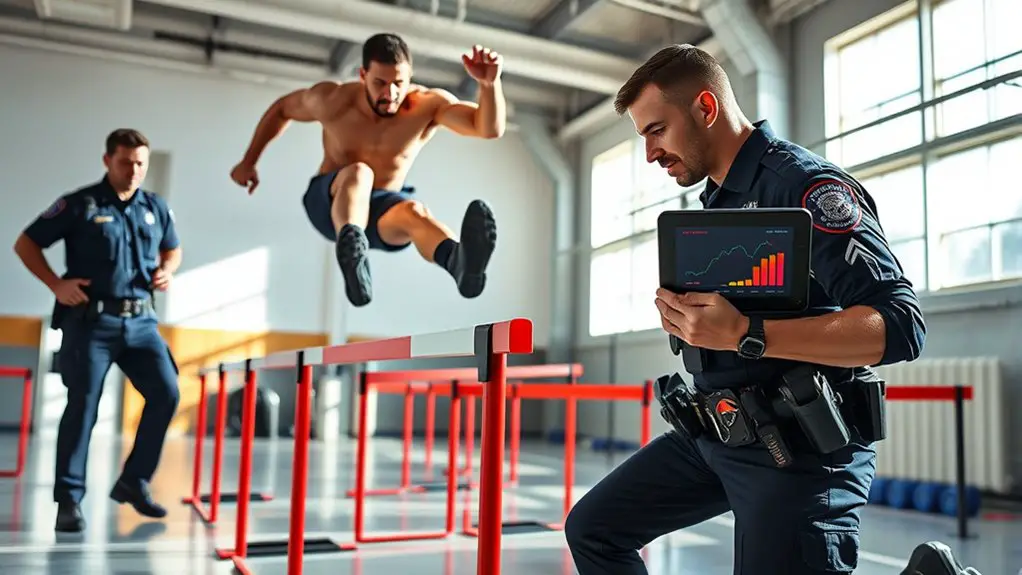How Police Officers Can Train for Strength and Agility

To enhance your strength and agility, focus on a balanced training program that combines compound exercises, like squats and deadlifts, with agility drills, such as ladder runs and shuttle sprints. Aim for three to four sessions a week, ensuring you include flexibility and mobility work to prevent injuries. Mixing in bodyweight exercises and varied agility patterns will boost coordination and speed. Keep pushing your limits, and you’ll discover even more ways to optimize your training.
Understanding the Importance of Strength and Agility in Law Enforcement

When it comes to law enforcement, strength and agility aren’t just nice-to-haves; they’re essential for your safety and effectiveness on the job. You face unpredictable situations that demand quick responses, whether chasing a suspect or restraining an individual. Understanding fitness psychology can help you harness your mental and physical capabilities, boosting your confidence and performance under pressure. Moreover, focusing on strength and agility is a key aspect of injury prevention. A well-conditioned body is less prone to injuries, allowing you to perform your duties without the setback of physical limitations. By prioritizing these elements in your training, you’re not only enhancing your performance but also ensuring your longevity in this demanding career. Embrace the importance of strength and agility, and you’ll find yourself better prepared for whatever challenges come your way. Remember, your physical readiness directly impacts your ability to serve and protect your community effectively. Additionally, incorporating effective cardio workouts like skipping rope can significantly enhance your agility and endurance.
Key Components of a Strength and Agility Training Program
A well-structured strength and agility training program is essential for enhancing your performance as a police officer. Focus on balancing strength training with agility techniques to develop both explosive power and quick reflexes. Start by incorporating compound movements like squats, deadlifts, and bench presses to build foundational strength. Aim for three to four sessions a week, allowing sufficient recovery to avoid injury.
Incorporate agility drills like ladder runs, cone sprints, and shuttle runs to improve your coordination and speed. These exercises not only boost your agility but also mimic the dynamic situations you may face on the job.
Don’t forget to prioritize flexibility and mobility, integrating stretching and dynamic warm-ups into your routine. This holistic approach will guarantee you’re physically prepared for the demands of law enforcement. Stay consistent and motivated, and you’ll see significant improvements in your overall performance and readiness.
Essential Exercises for Building Strength

Strength training is essential for police officers, and incorporating key exercises can greatly improve your performance on the job. Focus on a mix of bodyweight exercises and resistance training to build strength effectively. Push-ups and pull-ups are excellent bodyweight exercises that engage multiple muscle groups, enhancing your upper body and core strength. Squats and lunges not only develop leg muscles but also improve stability, vital for dynamic movements during duty. For resistance training, consider incorporating weights or resistance bands into your routine. Deadlifts and bench presses can greatly increase your overall strength and power. Aim for a balanced regimen, targeting all major muscle groups at least twice a week. Additionally, incorporating jump rope workouts can enhance cardiovascular endurance, which is crucial for police officers during physically demanding situations.
Agility Drills to Enhance Performance
To effectively navigate the unpredictable environments police officers often face, incorporating agility drills into your training routine is essential. Start with agility ladders; they’re fantastic for improving foot speed and coordination. Set up the ladder on a flat surface and practice various patterns like quick feet, lateral shuffles, and in-and-out movements. These drills will sharpen your reflexes and enhance your overall agility.
Next, obstacle courses can take your training to the next level. Create a course that simulates real-life scenarios, including sprinting, jumping, and dodging. This not only boosts your agility but also builds decision-making skills under pressure.
Incorporating Functional Training Into Daily Routines

Agility drills are just one piece of the puzzle when it comes to preparing for the challenges of police work. Incorporating functional fitness into your daily routines can greatly enhance your strength and agility. Think about it: simple actions like squatting to tie your shoes or lunging while reaching for equipment can turn everyday tasks into effective workouts.
You don’t need a gym to get stronger. Use your environment; perform push-ups against a wall or step-ups on a sturdy curb. Get creative with resistance bands or bodyweight exercises during breaks. Even short bursts of functional movements can improve your endurance and agility, making you better prepared for the demands of the job. Engaging in activities like skipping rope can provide both aerobic and anaerobic benefits, enhancing overall fitness levels.
The Role of Flexibility and Mobility in Training
While you might focus on strength and endurance, flexibility and mobility are equally essential in police training. Incorporating flexibility benefits into your routine can enhance your overall performance, reduce injury risk, and improve recovery times. Utilizing mobility techniques, like dynamic stretches and foam rolling, can help maintain ideal range of motion.
Here’s a quick reference table to guide your training:
| Flexibility Benefits | Mobility Techniques |
|---|---|
| Improved joint health | Dynamic stretching |
| Enhanced athletic performance | Foam rolling |
| Reduced muscle tension | Static stretching |
Embracing these elements into your training regimen not only prepares you for the physical demands of your job but also boosts your confidence. Remember, a well-rounded approach guarantees you’re not just strong, but agile and ready for any situation. Prioritize flexibility and mobility for the best results!
Monitoring Progress and Adjusting Training Regimens

As you commence your fitness journey, it’s essential to monitor your progress and make adjustments to your training regimen. Regular progress tracking allows you to identify what’s working and what isn’t. Consider keeping a journal or using apps to log your workouts, noting your strength gains, agility improvements, and overall endurance.
Every few weeks, evaluate your performance metrics. Are you lifting heavier weights? Are your sprint times improving? If not, it might be time for regimen adjustments. Perhaps you need to increase intensity, diversify your exercises, or incorporate more recovery time.
Frequently Asked Questions
How Often Should Police Officers Train for Strength and Agility?
Training for strength and agility is like sharpening a sword; it’s essential for cutting through challenges. You should aim for at least three to four sessions a week, balancing training frequency with workout intensity. Each session should push you just enough to build resilience without risking injury. Remember, consistency is key. You’re not just building muscle; you’re fortifying your ability to respond effectively in high-pressure situations. Stay committed, and you’ll see results.
What Nutrition Guidelines Support Strength and Agility Training for Officers?
To support your strength and agility training, focus on nutrient timing and hydration strategies. Eat a balanced meal with protein and carbs within 30 minutes post-workout to refuel effectively. Stay hydrated throughout the day, especially before, during, and after training sessions. Incorporating electrolytes can also enhance performance. Remember, good nutrition fuels your body, helping you build strength and agility while keeping your energy levels high for those demanding shifts.
Can Strength Training Prevent Injuries in Law Enforcement?
You might think strength training’s just about bulking up, but it’s actually a powerful tool for injury prevention. When you engage in regular strength training, you enhance your muscle resilience, improving your overall stability and reducing the risk of injuries. The training benefits extend beyond muscle gain; they help you perform better under stress. So, by incorporating strength exercises into your routine, you’re not just getting stronger, you’re also protecting yourself on the job.
Are There Specific Age-Related Considerations for Training Police Officers?
When considering age-related factors in training, it’s essential to implement age-specific training programs. Younger officers can focus on building strength and speed, while senior officer considerations should prioritize joint health and flexibility. You might need to adjust training intensity and recovery times based on age, ensuring everyone stays engaged and effective. Remember, adapting workouts to individual needs not only enhances performance but also promotes longevity in your career. Stay strong and agile!
How Can Officers Balance Training With Their Demanding Schedules?
It’s funny how, with a little creativity, you can find time in a packed schedule. To balance training with your demanding duties, consider implementing effective time management strategies. Break your training into shorter, focused sessions that fit into your day. Prioritize flexibility in your training schedule, making adjustments as needed to accommodate shifts or unexpected calls. Remember, staying consistent—even in small doses—can lead to significant improvements over time. You’ve got this!





